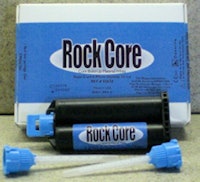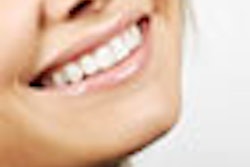
Are you using a composite that is specifically designed and engineered for core buildup (BU) procedures? Perhaps, for convenience, you use your universal, aesthetic composite for everyday restorations?
Having worked in and attended trade shows in more than 20 countries, I am still amazed at how many practitioners use their universal composite for core BU restorations, especially overseas. I can fully understand the reasons: the universal composites are exactly that -- they can be used for restoring any tooth; they are available in many shades, translucencies, and opacities; and it streamlines the ordering process and minimizes office inventory. And a survey conducted by DentalTown in 2004 reported that 26% of respondents still use their universal composite in lieu of a core BU resin.
So why would you choose to purchase, inventory, and use a core BU composite? There are many reasons, but perhaps the most important is that core materials are often a quarter of the price per gram compared to aesthetic universal resins. Since a BU often requires large amounts of composite, this can be a significant savings.
Unlike 20 years ago, today we have many choices in the core material category. The 2010 Henry Schein supply catalog lists 47 different resin core materials available to the dentist. Among the 47 choices you will find:
- Single-component light-cured (LC) core materials; these have a high-viscosity, paste-type consistency like a universal composite
- Dual-cured (DC) core materials in a flowable consistency
- Self-cured (SC) core materials in a flowable consistency
- Composites that serve as both a core material and a cement for endodontic posts -- I call these low-viscosity materials "combination core" BU resins; they are available as:
- Dual-cure resins
- Self-cure resins
- Shade choices of core materials include:
- Natural
- Blue
- Gold
- Opaque white (affectionately known as "toilet bowl" white)
- Regular white
- Tooth shade (somewhere between A2 and A3.5 Vita shades)
- Dentin shade
- Enamel shade
According to the 2004 DentalTown survey, 74% of respondents prefer a core-cement combination resin, which makes the material even more versatile for those cases where you need to bond a post and place a core BU. Indeed, this is the current purchasing trend among dentists. This not only simplifies inventory; it means having only one material in the operatory for both the post cementation (when a post is indicated) and the core BU procedure.
Going generic
So why is a core material about a quarter of the price of a universal composite? Did you notice in the list above, under "shade choices," the shades are all generic? This is one reason core materials are less expensive.
The universal aesthetic composites are available in 10 to 30 different Vita shades. Plus there is usually opaque dentin Vita shades, translucent versions, and transparent incisals by some manufacturers. When manufacturing a Vita shade, the final product must pass a strict quality assurance/quality control (QA/QC) examination to ensure that the dentist gets the shade he or she expects. If the shade is "off" or incorrect from the mixing process, QA/QC rejects the batch, which might be as much as 2 kg -- enough to fill nearly 1,000 syringes in some cases.
With generic shades, the shade specifications are not as strict, so being rejected due to shade nonconformity is rarely a problem. In addition, some core materials are made with less expensive fillers and resin, further reducing the cost of manufacturing. They are also offered in bulk dual syringes, again reducing the cost per gram to the dentist.
Comparing composites
Core materials are chemically engineered for high strength, not necessarily high polishability, surface gloss retention, and attrition or abrasion resistance. Likewise, the concrete for a house foundation is not the same as that for driveways or sidewalks.
The table below shows three universal composites compared to several popular core materials.
|
||||||||||||||||||||||||||||||||||||||||||||||||||||||||||||
|
LC = light cured; DC = dual cured 1Based on directions 2Pricing based on single refills; Henry Schein Internet pricing as of October 12, 2010 |
||||||||||||||||||||||||||||||||||||||||||||||||||||||||||||
 Figure 1: Rock Core by Danville Materials.
Figure 1: Rock Core by Danville Materials.One of the combination products (for core BU and post cementation) you should consider is Rock Core from Danville Materials. It is packaged in a large cartridge and is one-quarter the price per gram of the universal composites.
Rock Core releases fluoride and has excellent rheology properties, which means it flows nicely around the prep ensuring intimate contact with the adhesive and into the microscopic irregularities present in every preparation. However, I think the best feature of this material is the ability to stack it up inside the prep without slumping or running, thus it dispenses like a cement but behaves like a core material (figure 2).
 Figure 2: Rock Core stacks up like an ice cream cone without running or slumping.
Figure 2: Rock Core stacks up like an ice cream cone without running or slumping.Many of the combination core materials act exclusively like a cement. This means they slump and run out of the prep during placement unless you cure it in small increments. With a flexural strength of 151 MPa, Rock Core well exceeds that of expensive universal composites (usually 100-120 MPa) with much higher filler loading.

 Figures 3 and 4: Top, loading the Mojo syringe. Bottom, Mojo syringe loaded with unmixed catalyst and base. Note extended tip for easy access to preps or post canals.
Figures 3 and 4: Top, loading the Mojo syringe. Bottom, Mojo syringe loaded with unmixed catalyst and base. Note extended tip for easy access to preps or post canals.Using the large dispensing gun to deliver core materials can be cumbersome if not impossible in many situations. Danville designed a hand syringe (available separately) named the Mojo syringe (figure 3), that can be filled from the large cartridge then used intraorally for those hard-to-reach preps and post canals. What is especially nice is that the dual-barrel syringe butts onto the end of the larger cartridge for filling unmixed resin. Since the core material has not been mixed but rather dispensed into the two barrels, you can now load it ahead of time so it is ready for use when you need it. The narrow gauge barrels make it easy to dispense for female dentists or those with small hands.
The syringe can also be used with PVS materials and cartridges using the same loading technique. And Danville Materials will soon have a light-protected version so that the syringe can be filled and used several times by just disinfecting it like PVS cartridges that are used intraorally, according to Patrick Roetzer, D.D.S., director of clinical affairs at Danville Materials. The syringe comes with standard contra-angle tips plus an extended tip to navigate down endodontic post holes, as shown in figure 4.
We now have many core material choices to best fit our restorative philosophy. As shown above, using a core material that is substantially less expensive than a universal composite is not a compromise in care, and, in fact, the core materials are often stronger than our flagship composite.
Copyright © 2010 DrBicuspid.com



















